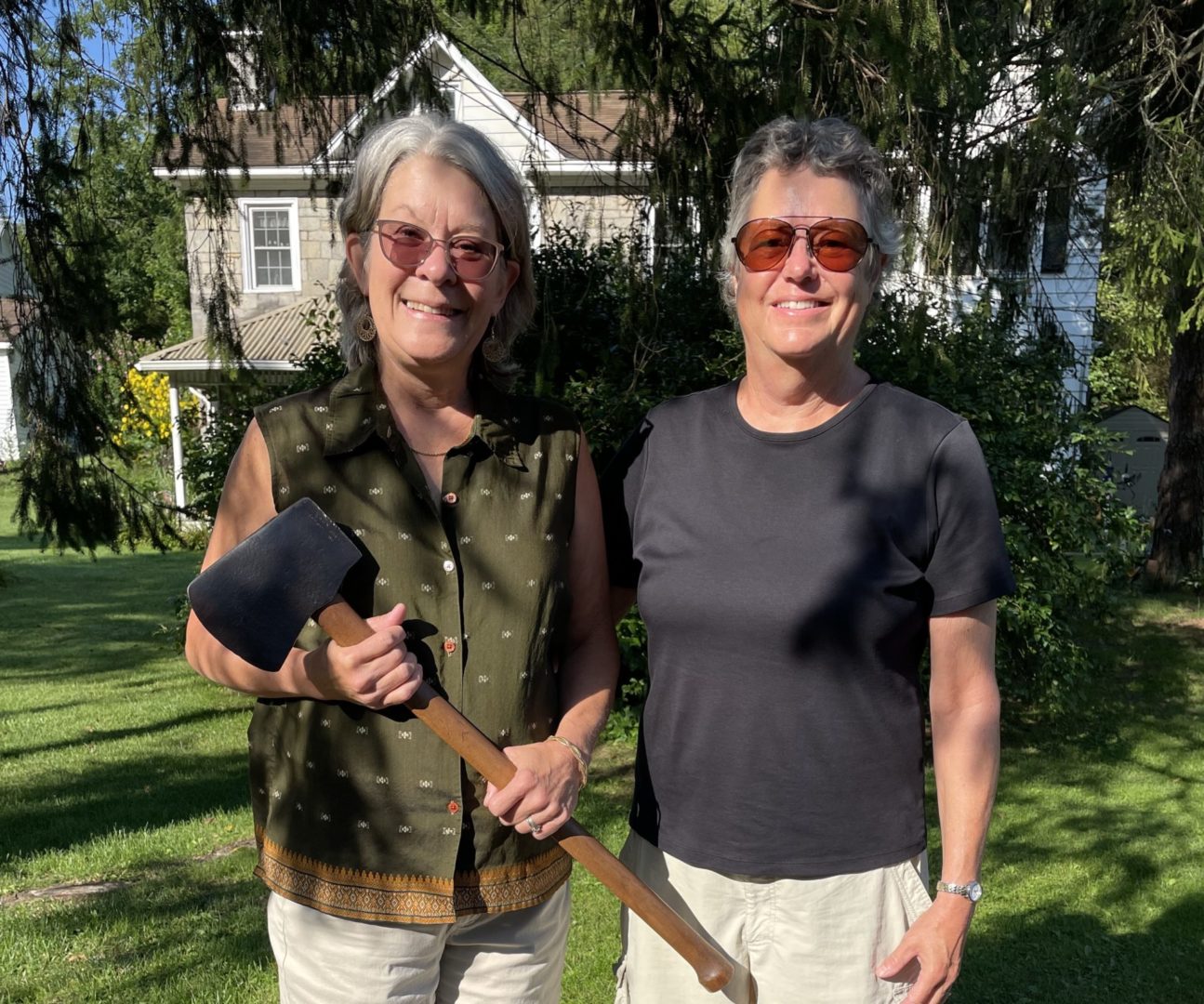Sometimes the most dedicated caregivers of history are the homeowners of historic properties. Deborah and Elizabeth Hamilton purchased a little piece of Axemann history in 2007. They are seen in the photo holding their 19th century Harvey Mann axe stamped “H. Mann Centre Co.” The couple is standing in front of the original Harvey Mann house dating to the 1820s, on the very grounds where this axe was manufactured. The Hamiltons fall in a long line of homeowners and other locals who have become enamored with the history of Axemann. This same home once belonged to Henry “Hank” Hager, who was also deeply invested in Axemann’s history and the world-renowned axes it once produced.
The former Hager house, now Hamilton, is just below a spring that falls into the Logan Branch. This little hamlet, once called Boiling Spring, sits between Pleasant Gap and Bellefonte. It’s a place where some of the best axes ever produced were made and shipped all over the United States and even the world.
By 1885, folks in Boiling Spring were tired of going to Bellefonte to get their mail and were ready to establish a post office. However, when J. Fearon Mann made an application, the Post Office Department requested an alternative name, as there was already a town with the same name in Pennsylvania. Axemann was a natural fit.
The Mann family, hailing from Ireland, came from a long line of blacksmiths. Before the Industrial Revolution, a blacksmith would make an entire tool from start to finish, one axe at a time. However, a quarter into the 19th century, brothers William and Harvey Mann figured out a way to divide the axe-smithing process into skilled jobs and started manufacturing them in one of the first plants in America where axes were made by machinery at an industrial level. William Mann, seeing the potential of the Juniata Iron District, convinced his brother to move from New York to Bellefonte with him in 1825 when they rented John Hall’s blacksmith shop. After making axes in Bellefonte, the Mann brothers purchased the land near Boiling Spring from Judge Thomas Burnside and opened their axe factory in 1829. Harvey Mann married the judge’s daughter, Jane Burnside, and they moved into their home, called Edgefonte, the same year.

In 1979, Hager conducted in-depth research on the Harvey Mann Axe Manufactory and identified many of the features of the site. According to Hager, the land “was a rare, level spot on the stream affording sufficient space for mill ponds and efficient lay-out of buildings to house progressive steps in production.” Also, the relative location of the factory to many forges and furnaces nearby was vital.
The Bellefonte Forges and Logan Furnace were within a mile north and south, respectively. Also, pig and wrought iron could be sourced from nearby Centre Furnace, Rock, Eagle and Howard Iron Works. In addition, transportation along the Lewistown Pike was established by the Centre and Kishacoquillas Turnpike Road Company in 1822 and increased connections to markets were made by the canal system after 1834 and the Bellefonte, Nittany, and Lemont Railroad after 1884.

Hager’s house was at the heart of the industrial site, aside from being the original Mann house. The Hamiltons believe that a manager once lived there to oversee operations, as it has a side door to an office. There was much to manage, as the plant grew from producing about a dozen axes a day in the 1830s to 350 in 1880. There were also about 50 men employed at that time.
Also according to Hager, one of the two forges was located at the current location of the structure painted with the Mail Pouch Tobacco sign. In addition to the water-powered forges, the complex had mill ponds, races, and grinding and polishing shops, as well as the old Harvey Mann general store that served the small community since 1830.

When William Mann left Boiling Spring in 1834, Harvey was the sole owner of Harvey Mann Axe Factory. William attempted to establish factories in Tyrone and Mauch Chunk (Jim Thorpe, Pa.) before finding success in Mifflin County. Harvey Mann passed away in 1870, but Axemann production continued to thrive under other owners like J. Fearon Mann until it closed in 1892. The Mann name and enterprise continued to be synonymous with axes with operations in Mill Hall and Lewistown even into the 21st century. However, Axemann, formerly known as Boiling Spring in the 1820s, was the epicenter of legendary axes and stories that will hopefully continue to inspire locals to preserve and keep its history sharp for generations to come.

Local Historia is a passion for local history, community, and preservation. Its mission is to connect you with local history through engaging content and walking tours. Local Historia is owned by public historians Matt Maris and Dustin Elder, who co-author this column. For more, visit localhistoria.com .




